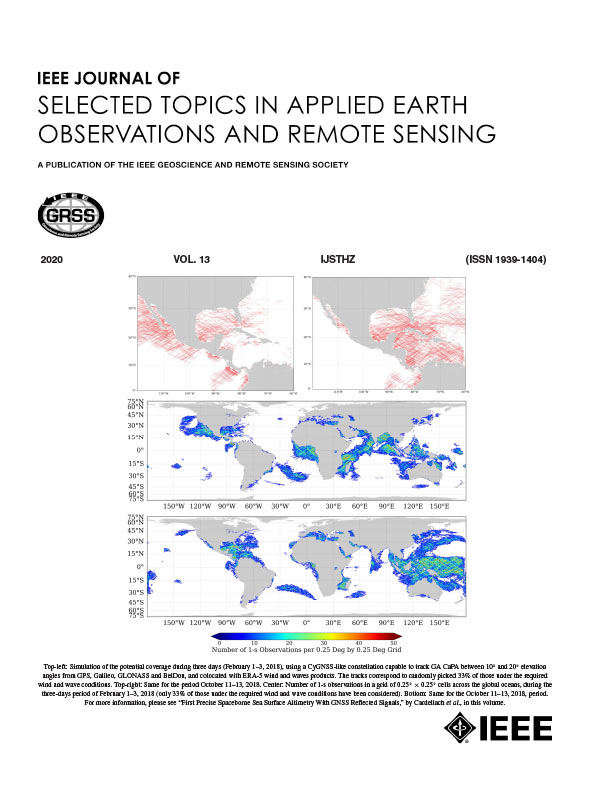利用分布对比网络从多视角立体卫星图像估算地表深度
IF 4.7
2区 地球科学
Q1 ENGINEERING, ELECTRICAL & ELECTRONIC
IEEE Journal of Selected Topics in Applied Earth Observations and Remote Sensing
Pub Date : 2024-09-24
DOI:10.1109/JSTARS.2024.3457616
引用次数: 0
摘要
基于多视角立体(MVS)卫星图像的表面深度计算在军事和测量等领域具有重要意义。从卫星图像中提取深度信息的挑战在于,这些图像通常呈现相似的颜色,因此有必要开发能够整合形状和纹理信息的算法。此外,经典卷积神经网络(CNN)MVS 的应用也受到限制,因为它无法捕捉远距离地形关系,这成为现有地表深度估算算法的瓶颈。为解决上述问题,我们提出了一种新型卫星 MVS 网络--卫星多视角立体图像表面深度估算分布对比网络(DC-SatMVS)。为了学习短程和远程特征,我们设计了独立的 CNN 和 ViT 分支。为了强调形状和纹理的重要性,我们提出了分布对比度损失机制。该机制根据预测深度与地面真实深度分布之间的相似性来监督模型训练。实验结果表明,我们的方法达到了最先进的(SOTA)性能。在 WHU-TLC 数据集上,与 Sat-MVSF 相比,我们显著降低了 18.14% 的均方根误差。为了验证我们框架的泛化性能,我们在 DTU 数据集(一种常见的 MVS 数据集)上对其进行了训练和测试,在该数据集上也取得了 SOTA 的结果。本文章由计算机程序翻译,如有差异,请以英文原文为准。
Surface Depth Estimation From Multiview Stereo Satellite Images With Distribution Contrast Network
The calculation of surface depth based on multiview
s
tereo (MVS) satellite imagery is of significant importance in fields such as military and surveying. The challenge in extracting depth information from satellite imagery lies in the fact that these images often exhibit similar colors, necessitating the development of algorithms that can integrate shape and texture information. Moreover, the application of classical convolutional neural network (CNN) MVS is limited by its inability to capture long-range terrain relationships, which presents a bottleneck in existing surface depth estimation algorithms. To address the above problems, we propose the Distribution Contrast Network for Surface Depth Estimation from Satellite Multi
V
iew
S
tereo Images (DC-SatMVS), a novel satellite MVS network. In order to learn short-range and long-range features, we designed separate CNN and ViT branches. To emphasize the importance of shape and texture, we propose the Distribution Contrast Loss mechanism. This mechanism supervises the model training based on the similarity between the predicted depth and the ground truth depth distribution. Experimental results demonstrate that our method achieves state-of-the-art (SOTA) performance. We produce a remarkable 18.14% reduction in root mean square error compared to the Sat-MVSF on the WHU-TLC dataset. To validate the generalization performance of our framework, we trained and tested it on the DTU dataset, a common MVS dataset, and achieve SOTA results in this dataset as well.
求助全文
通过发布文献求助,成功后即可免费获取论文全文。
去求助
来源期刊
CiteScore
9.30
自引率
10.90%
发文量
563
审稿时长
4.7 months
期刊介绍:
The IEEE Journal of Selected Topics in Applied Earth Observations and Remote Sensing addresses the growing field of applications in Earth observations and remote sensing, and also provides a venue for the rapidly expanding special issues that are being sponsored by the IEEE Geosciences and Remote Sensing Society. The journal draws upon the experience of the highly successful “IEEE Transactions on Geoscience and Remote Sensing” and provide a complementary medium for the wide range of topics in applied earth observations. The ‘Applications’ areas encompasses the societal benefit areas of the Global Earth Observations Systems of Systems (GEOSS) program. Through deliberations over two years, ministers from 50 countries agreed to identify nine areas where Earth observation could positively impact the quality of life and health of their respective countries. Some of these are areas not traditionally addressed in the IEEE context. These include biodiversity, health and climate. Yet it is the skill sets of IEEE members, in areas such as observations, communications, computers, signal processing, standards and ocean engineering, that form the technical underpinnings of GEOSS. Thus, the Journal attracts a broad range of interests that serves both present members in new ways and expands the IEEE visibility into new areas.

 求助内容:
求助内容: 应助结果提醒方式:
应助结果提醒方式:


